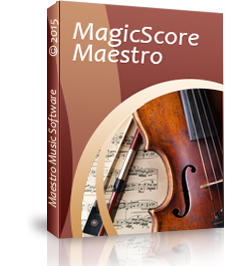MagicScore Maestro — Music Composition and Music Notation Software
Music composition software
MagicScore Maestro 8 allows you to turn your musical ideas into clean, playable, and easy to read music notation files by using one of the most powerful and customizable music scoring systems on the market today. With MagicScore Maestro you can create clean, engraver quality prints of your music with a minimum of effort and time. You also get all of the features found in our Maestro Notation program, plus the ability to have total musical control over every single note in the entire composition. When the creative mood hits or a deadline looms you want to be able to get your musical ideas down quickly, easily, and accurately with many different presentation options. MagicScore Maestro provides all of these things within a set of features that rivals all other professional level music notation and composition products.
Easy and Versatile Note Entry Options
MagicScore Maestro provides you with a dozen different ways to enter notes into a score while also making it possible to listen to the music as you write it. With nothing more than the computer keyboard musicians can speed through an entire composition by using MagicScore Maestro’s Quick Input mode or use a mouse along with a variety of other note entry methods such as step time and real time note entry with a MIDI keyboard. You can even enter notes using our handy on-screen piano keyboard or virtual guitar fretboard. Extracting and printing individual parts from complex scores is easy to do and allows for each part to be customized and formatted as desired by the publisher. Rewrite or transpose existing scores for other instruments with just a few simple mouse clicks.
Flexible Visual and Audio Controls
Each individual element in a MagicScore Maestro score is able to be edited and moved wherever the composer desires. Simply point and click on clef signs, brackets, bar lines, articulations, or individual notes to place them precisely where you need them on the page. These powerful visual layout tools are matched with an equally powerful set of options that, if needed, can help a composer fine tune audio playback to control details such as the attacks and releases of individual notes. Full ensembles or individual instrumental parts can then be played back or exported directly into high quality MP3 or WAV format audio files using realistic sf2 sound fonts.
Publish Your Music To A Variety Of Different Formats Including To The Web
Completed scores can be saved and printed in many different ways using MagicScore Maestro. Scores can be printed, exported to Adobe PDF format, saved as SFD (our own music notation file format), or as MusicXML, MIDI, or KAR (Karaoke format) files. Completed pages can also be saved in many different graphics formats including JPG, GIF, PNG, BMP, TIFF, and WMF in resolutions of up to 1200dpi. For those that want to share their documents on the web, users can upload their saved files to a web site and directly embed their scores into any web page, giving visitors the ability to play, listen, transpose, or print the music as needed.
Easily Create Educational Materials
Teachers and ensemble conductors will find it very easy to quickly create music education worksheets, playing exams, and study guides using MagicScore Maestro. Once the music has been entered into the system you can export individual lines of the score to create recordings that your students can use to practice more effectively. Use the Copy as Picture feature to export portions of the score as image files that can be used with Microsoft Word or other similar programs.
You can even use this music composition software together with a video projector to demonstrate musical concepts to entire classrooms at once. For even greater flexibility you can also embed other documents such as MS Word, Photoshop, Corel, Excel, and many others directly into your MagicScore Maestro score.
Open Your Music In A Variety of Other Applications
As mentioned previously, MagicScore Maestro has the ability to save your music in a variety of output formats including the WAV and MP3 audio file formats. For those that need to share their creations visually with other musicians MagicScore Maestro can open and export documents as MIDI or Karaoke files as well as in the industry standard MusicXML file format, allowing scores to be opened in dozens of other music applications. Scores saved with previous versions of MagicScore Maestro (or its predecessor, MagicScore) can be opened, edited, and saved in newer versions of the software.
Intuitive and Multifaceted Help System
MagicScore Maestro provides you with many different ways to get help while creating your scores. A traditional help system is combined with flash based training videos, built in lessons, and an intuitive contextual help system that follows your actions and provides suggestions on what to do next. For the rare question that cannot be answered within the help system web based forums and email support options are also provided.
System requirements
Windows 10, 8, 7


















 English
English Deutsch
Deutsch Русский
Русский